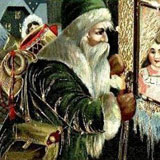Saint Nick: Loving Saint or Something Else?

St. Nicholas, known to some as St. Nick, has become a beloved character throughout all of Christendom. He is known and adored by all for his secret gift-giving. Everyone has heard of him, but what do we actually know about him? Let's explore the information available on his life.
As the picture shows, St. Nick lived in an age when everything was golden and colorful: 4th century Turkey . He was a Bishop there and had a reputation for his kindness and charity. One common story about St Nicholas is that he supplied three young girls with dowries by secretly leaving bags of gold in their houses. This way there would be no need for them to resort to prostitution to earn money. It was also reported that he saved some sailors who were in a difficult situation, even though they were probably swearing at the time.
There is also a story that he brought three dead kids back to life. The children had been killed during a time of famine by an Innkeeper who served their flesh to guests. I'm not sure how they were brought back to life after they had been eaten, but is that really more mysterious than transubstantiation? He is the patron saint of several groups. I divided them into two categories: savory and unsavory. The savory group is comprised of archers and children. The unsavory group includes prostitutes, pharmacists, merchants, lawyers, pawnbrokers, prisoners and seamen. There is great wisdom in being the patron of both prostitutes and seamen since they are usually in the same place at the same time. This is what we know about St. Nicholas. At least that's the spin "the man" puts on it, and by "the man" I mean the Pope. If I have learned anything from Matin Luther, the King James translators and Sinead O'Connor it's that we can't always trust the Pope's portrayal of every situation.
In the holiday spirit of mistrust I have my own spin on who St. Nick was. He was clearly an extra-terrestrial visitor. Ridiculous you say! Moronic you say! Let me explain myself. I think you'll change your tune. The aforementioned information on St. Nicholas should be proof enough that he was not human. Only an alien could be so out of touch with our way of life that he would find it normal to throw money at poor girls, bring stupid dead kids back to life, or help sailors. These are examples of totally unacceptable behavior that no human would engage in. Throwing money at poor girls is weird, unless they're prostitutes-and that's what he was preventing by throwing money. Humans would never help sailors for several reasons: sailors swear, they have crazy hats, and if you're around them you run the risk of contracting scurvy or even the bends. The greatest proof of his unearthly origin is bringing dead children back to life. Earthlings do not know how to resurrect their dead. Resurrection would require very advanced technology-alien technology. The kind of technology an alien would have. An alien like St. Nick.
Aside from his unusual behavior and his advanced technology there is the matter of his appearance. The above illumination shows several features not exhibited by Homo sapiens. Let's examine these features.
 |
Observe the unusual bulges on his forehead. These bulges would be needed to accommodate the shape of non human frontal lobe. See how narrow his nose is. It is not sufficiently wide for breathing purposes. We could only speculate as to its function. |
 |
Notice the bend in his fingers. They do not bend on joints. The curvature is more snake-like, suggesting that St. Nick did not have bones as humans do. |
 |
We must also take a closer look at the literature he's displaying. At first glance it appears to be the Bible. When given a closer look it is a discussion of physics. The knowledge of various kinds of physics is far beyond the understanding of 4th century Turks. |
Such understanding could only have come from the stars. I have proven beyond any rebuttal that St. Nicholas was not human, but a visitor from beyond our solar system. His knowledge was far beyond that of his day and his behavior was anything but human.
December 2005










